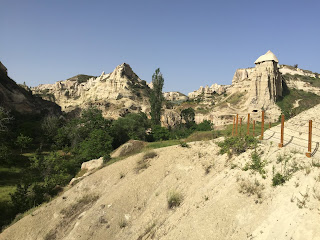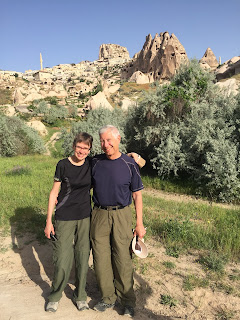The sun was streaming through our hotel room window by 5 a.m. and we were up at 6. At 7 a.m. we joined our tour leader and one other member of the group for an early morning hike through the Pigeon Valley.
The Valley gets its name from the many bird shelters that were carved into the soft stone among the strange rock formations that go on here for many miles. It’s sort of Turkey’s answer to the Badlands of South Dakota, except that people have lived here for thousands of years. They carved cave homes for themselves in the soft rock, but they also carved roosts for birds so that the droppings could be gathered for fertilizer.
Getting down into the Valley was something of an ordeal. The path was very steep, and wherever there was loose sand or gravel things got very slippery. Once down, we were surprised at how much vegetation there was. There is water at the bottom, and it tends to be much cooler.
Once we got used to the fact that there was grass and shrubbery on the valley floor, the next surprise was agriculture. There are vegetable gardens and orchards hidden down here that we could not make out from the top. Some have elaborate irrigation systems in place.
We passed a cave home that appeared to be occupied. Our approach was announced by a very large and protective kangal — a breed of dog unique to Turkey, also known as an Anatolian Shepherd. Fortunately, it was on a chain. They have a reputation for being viciously loyal to their owners.
An elderly woman, working in her garden, noted our passing. Ersin, our tour leader, indicated that she probably does not live in the cave year round, but only part time in the garden season. She would have a more modern home in town.
The views in the valley were quite stunning, and the work of the cave carvers over the centuries is fascinating. One can easily spot the few cave dwellings still in use, because they almost always have an electrical power source and a satellite dish.
We finished our hike in the next village, called Göreme, almost 3 miles from our starting point. Just about the time we were realizing that we were entering a different village, and had not circled back to our starting point, Ersin surprised us by having our bus waiting there to whisk us back to the hotel.
We had about and hour to shower, change, and grab breakfast before joining the entire group back on the same bus to retrace our route and return to Göreme once again. This time the bus let us off at the Göreme Outdoor Museum.
From about the 4th century AD until the 10th or 11th century, this had been a Christian monastery devoted to St. Basil. The monk cells, refectories, churches, and tomb chapels were all carved from the rock. Frescoes on the walls of the churches date back 1,000 years, and the caves have done a fine job of preserving them.
Photos are not allowed in the caves in the museum, but everyone was sneaking a few when the guards weren’t looking. There were lots of photos, however, that we only wished we could have taken.
In the refectories, the rock carvers had taken care to leave stone tables and benches as unmovable furniture. In the adjacent kitchens, the ceilings were still blackened from cooking fires. Since there were no chimneys, those who cooked must have been constantly breathing smoke.
While the three churches and two chapels we visited were all wonders to behold, the final church (which few people even seemed to notice, because it is outside of the museum, down by the tour bus parking lot) was by far the largest and the most impressive. I wish we could have photographed the detailed and very well preserved frescoes here.
The bus took us from the museum to an overlook where we could view a formation known as the “Three Beauties,” or the three “Fairy Chimneys” of Cappadocia.
Another photo opportunity was at a spot known as the “Valley of Imagination.” The shapes here remind viewers of various things. The camel formation is fairly obvious, but for many of the others, one must use his or her imagination (hence the name).
We overheard a guide from another group pointing out a rock formation that remind some of J-Lo (pop singer Jennifer Lopez). That one required more imagination than we could muster.
A final photo stop provided a panorama of the valley, but it was already 93 degrees Fahrenheit in this barren, shadeless land, so we weren’t eager to linger.
The bus took us on to yet another village, Avanos, where we stopped for lunch at a restaurant on the banks of the Red River — the largest river that both starts and ends within Turkey. Because we have all been eating so much, and because of the heat, we all opted to skip straight to dessert.
Genuine Turkish ice cream is very hard, and in this location, unlike the street vendors, it is served in slabs in the traditional way. It was quite good.
We had some rest and refreshment time at the hotel. Ours was longer than for some in the group, as they chose to buy the optional performance by Whirling Dervishes. We had seen a similar performance in Egypt some years ago, so opted out.
When the Durvish performance ended, the entire group went together to a late dinner.
The Valley gets its name from the many bird shelters that were carved into the soft stone among the strange rock formations that go on here for many miles. It’s sort of Turkey’s answer to the Badlands of South Dakota, except that people have lived here for thousands of years. They carved cave homes for themselves in the soft rock, but they also carved roosts for birds so that the droppings could be gathered for fertilizer.
Getting down into the Valley was something of an ordeal. The path was very steep, and wherever there was loose sand or gravel things got very slippery. Once down, we were surprised at how much vegetation there was. There is water at the bottom, and it tends to be much cooler.
Once we got used to the fact that there was grass and shrubbery on the valley floor, the next surprise was agriculture. There are vegetable gardens and orchards hidden down here that we could not make out from the top. Some have elaborate irrigation systems in place.
We passed a cave home that appeared to be occupied. Our approach was announced by a very large and protective kangal — a breed of dog unique to Turkey, also known as an Anatolian Shepherd. Fortunately, it was on a chain. They have a reputation for being viciously loyal to their owners.
An elderly woman, working in her garden, noted our passing. Ersin, our tour leader, indicated that she probably does not live in the cave year round, but only part time in the garden season. She would have a more modern home in town.
The views in the valley were quite stunning, and the work of the cave carvers over the centuries is fascinating. One can easily spot the few cave dwellings still in use, because they almost always have an electrical power source and a satellite dish.
We finished our hike in the next village, called Göreme, almost 3 miles from our starting point. Just about the time we were realizing that we were entering a different village, and had not circled back to our starting point, Ersin surprised us by having our bus waiting there to whisk us back to the hotel.
We had about and hour to shower, change, and grab breakfast before joining the entire group back on the same bus to retrace our route and return to Göreme once again. This time the bus let us off at the Göreme Outdoor Museum.
From about the 4th century AD until the 10th or 11th century, this had been a Christian monastery devoted to St. Basil. The monk cells, refectories, churches, and tomb chapels were all carved from the rock. Frescoes on the walls of the churches date back 1,000 years, and the caves have done a fine job of preserving them.
Photos are not allowed in the caves in the museum, but everyone was sneaking a few when the guards weren’t looking. There were lots of photos, however, that we only wished we could have taken.
In the refectories, the rock carvers had taken care to leave stone tables and benches as unmovable furniture. In the adjacent kitchens, the ceilings were still blackened from cooking fires. Since there were no chimneys, those who cooked must have been constantly breathing smoke.
While the three churches and two chapels we visited were all wonders to behold, the final church (which few people even seemed to notice, because it is outside of the museum, down by the tour bus parking lot) was by far the largest and the most impressive. I wish we could have photographed the detailed and very well preserved frescoes here.
The bus took us from the museum to an overlook where we could view a formation known as the “Three Beauties,” or the three “Fairy Chimneys” of Cappadocia.
Another photo opportunity was at a spot known as the “Valley of Imagination.” The shapes here remind viewers of various things. The camel formation is fairly obvious, but for many of the others, one must use his or her imagination (hence the name).
We overheard a guide from another group pointing out a rock formation that remind some of J-Lo (pop singer Jennifer Lopez). That one required more imagination than we could muster.
A final photo stop provided a panorama of the valley, but it was already 93 degrees Fahrenheit in this barren, shadeless land, so we weren’t eager to linger.
The bus took us on to yet another village, Avanos, where we stopped for lunch at a restaurant on the banks of the Red River — the largest river that both starts and ends within Turkey. Because we have all been eating so much, and because of the heat, we all opted to skip straight to dessert.
Genuine Turkish ice cream is very hard, and in this location, unlike the street vendors, it is served in slabs in the traditional way. It was quite good.
We had some rest and refreshment time at the hotel. Ours was longer than for some in the group, as they chose to buy the optional performance by Whirling Dervishes. We had seen a similar performance in Egypt some years ago, so opted out.
When the Durvish performance ended, the entire group went together to a late dinner.

















No comments:
Post a Comment